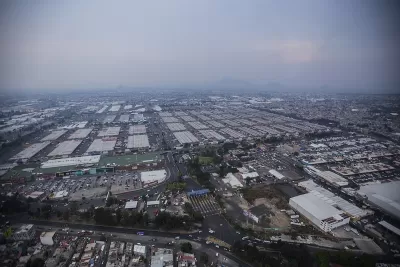A solar project atop a massive food market will provide electricity to Mexico City's public transit buses.

Thousands of solar panels on the roofs of Mexico City’s iconic Central de Abasto food market, one of the largest in the world, will be used to power the city’s transit buses, reports Valentine Hilaire in Bloomberg CityLab.
The project was announced in 2022 by then-mayor Claudia Sheinbaum, who was just inaugurated as Mexico’s first woman president. “During her presidential campaign, Sheinbaum pledged to strengthen state oil and electricity companies while also investing $13.6 billion in new power generation projects, including solar plants.”
According to Hilaire, “The first stage is complete and the rooftop panels are already powering selected parts of market, cutting its electricity bills. In the second phase, which is set [to] begin in January after additional work and testing, energy will be channeled toward the city’s transit system.”
The installation is expected to produce 26.5 gigawatt hours of electricity per year, which will eventually power 300 electric buses. Because a new entity was created to allow the market to trade energy with the transportation unit, the project offers a model for scaling the concept and letting more government buildings set up similar projects.
FULL STORY: Roofs of Mexico City’s Massive Food Market Will Power Public Buses

Planetizen Federal Action Tracker
A weekly monitor of how Trump’s orders and actions are impacting planners and planning in America.

Congressman Proposes Bill to Rename DC Metro “Trump Train”
The Make Autorail Great Again Act would withhold federal funding to the system until the Washington Metropolitan Area Transit Authority (WMATA), rebrands as the Washington Metropolitan Authority for Greater Access (WMAGA).

The Simple Legislative Tool Transforming Vacant Downtowns
In California, Michigan and Georgia, an easy win is bringing dollars — and delight — back to city centers.

In These Cities, Most New Housing is Under 441 Square Feet
With loosened restrictions on “micro-housing,” tiny units now make up as much as 66% of newly constructed housing.

Albuquerque’s Microtransit: A Planner’s Answer to Food Access Gaps
New microtransit vans in Albuquerque aim to close food access gaps by linking low-income areas to grocery stores, cutting travel times by 30 percent and offering planners a scalable model for equity-focused transit.

This City Will Pay You to Meet Your Neighbors
A North Kansas City grant program offers up to $400 for residents to throw neighborhood block parties.
Urban Design for Planners 1: Software Tools
This six-course series explores essential urban design concepts using open source software and equips planners with the tools they need to participate fully in the urban design process.
Planning for Universal Design
Learn the tools for implementing Universal Design in planning regulations.
Smith Gee Studio
City of Charlotte
City of Camden Redevelopment Agency
City of Astoria
Transportation Research & Education Center (TREC) at Portland State University
US High Speed Rail Association
City of Camden Redevelopment Agency
Municipality of Princeton (NJ)





























